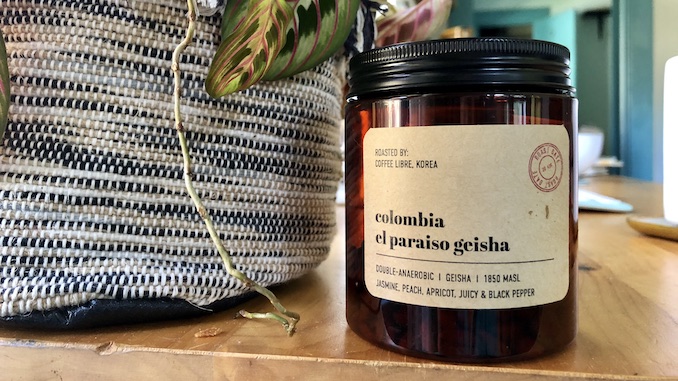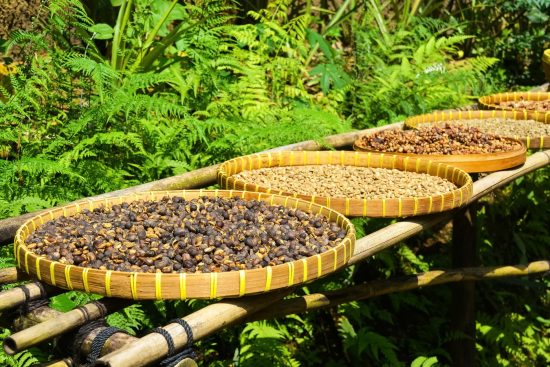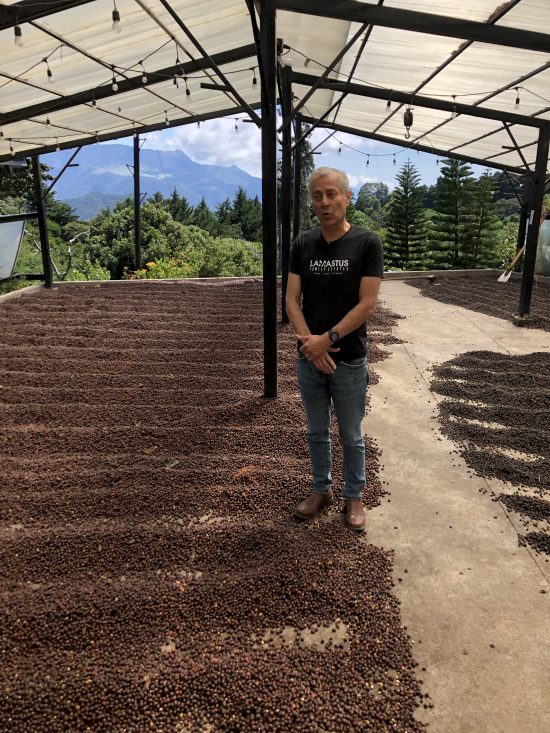
This quickly growing coffee-processing method is increasing in demand by specialty-coffee drinkers and roasters alike.
BY KATRINA YENTCH
BARISTA MAGAZINE ONLINE
Cover photo by Katrina Yentch
If you’ve read through our latest issue of Barista Magazine, you’ll notice a theme thanks to our cover stars Emi Fukahori and Mathieu Theis of MAME Coffee. “Funky and fruity” perfectly describes the trend and demand for interestingly processed coffees, which has been gathering momentum for the last several years now.
When the pandemic practically forced hundreds of café goers into the field of home brewing, we witnessed that much stronger of a consumer demand for coffees with interesting processing methods – one particular method that continues to boom in popularity is anaerobic fermentation. For many of us coffee people, we certainly recognize the method, and we know what it tastes like (fruity and funky deliciousness).
However, the actual steps that coffee farmers take to process this coffee may be a little difficult to explain to a customer holding a $30 USD-bag of coffee in their hand, wanting to know why they should spend the extra dough to indulge in this thoughtfully produced coffee. And so, we break down what anaerobic fermentation is, and how you can use it to offer a higher end option at your café.
The Basics of Coffee Processing Methods
Coffee processing refers to how producers transform the seeds of coffee cherries from a fresh by-product to the dry green beans that end up in a coffee roaster. There are many ways to do this, and the steps that go into processing green coffee play a huge factor in what the final brew will taste like.
Although many variables are involved in determining coffee flavors, the industry tends to focus a lot on processing methods when we’re adding information to coffee bags, café menus, selecting competition coffees, and more. As the industry continues to innovate in every aspect of coffee possible, the specialty-coffee producing community is just as quick and attentive to understanding what new and exciting things their customers want—and that’s nuanced processing methods.
Many will argue in circles about the validity of processing methods other than washed processing. None the less, it’s clear that coffees with natural process, honey process, and anaerobic fermentation are becoming the norm in the specialty-coffee market. For the purposes of this article, we’re focusing specifically on anaerobic fermentation.

What is anaerobic fermentation?
Besides being a big clunky phrase that reminds us of kombucha and natural wines, anaerobic fermentation is essentially a phase of coffee processing without air. Out of the context of coffee, fermentation is a process in which bacteria, yeasts, and other micro-organisms break down a product. Many will associate this with alcohol, in which fermentation converts certain sugars to ethyl alcohol.
When it comes to coffee, there are sugars caked to the coffee bean within the mucilage of the product—this isn’t to say that the sugars are converting to 100% alcohol though! All coffee processing technically experiences fermentation. During coffee fermentation, the mucilage breaks down and organic compounds that can contribute to flavor—such as certain acids—develop. Producers can manipulate the way that this fermentation happens. They use vessels like tanks, raised beds, and patios to do this.
In the case of anaerobic fermentation, however, the full coffee cherries go directly into oxygen-free tanks. During this time, as a result of an oxygen-free environment, the coffee produces interesting distinct flavors and lactic acids – which explains the “funky” elements of a final cup of coffee produced this way. Essentially, the way that producers expose coffee to oxygen can be a major factor in determining the flavor profile of the processing method.
If you’ve ever nursed a tub of kimchi or kombucha, you’ve probably had to open the jar every now and then to release the CO2 that builds up from the pressure of the environment. The same thing happens within the specialized tanks used for anaerobic fermented coffee; there are valves connected to the tanks that will release the pressure and oxygen from them. Just think about it like you would a bag of roasted coffee; as the fresh beans release CO2, the specialized valve attached to the bag allows this to happen while preventing oxygen from entering the bag.
Coffees are still further processed after this step, whether it be through natural, honey, or washed methods. However, thanks to the additional step of anaerobic fermentation, the cherries are now imparted with those distinct flavors that happened during this process.
How do I explain anaerobic fermentation to a customer without intimidating them??
If someone wants to know what anaerobic fermentation is, and they’re in a hurry, you can let them know that it is coffee that is fermented without oxygen. Making the above-mentioned comparisons to kombucha, natural wine, and kimchi can also be other ways to help a customer understand the concept—explain how coffee cherries are processed in a way that oxygen and CO2 are constantly being removed, and how that produces special, unique flavors that they won’t be able to find with other coffees.

Why do coffees with anaerobic fermentation cost more?
One of the biggest reasons why coffees processed with methods other than washed process is the inconsistencies of them. Therefore, they must be more closely monitored than other coffees, produced in small batches, and are inherently riskier to work with.
Wilford Lamastus Jr. is the Panama Brewers Cup Champion and a fourth-generation producer at Lamastus Family Estates, who explains it like this: “Anaerobic fermentation gets to be inconsistent in many cases. What you got that you loved is not always going to be the result … Producers in search of ‘consistency’ do adulteration on the coffees that sometimes becomes a transparency issue.”
However, as evidenced by the industry’s earlier adoration with natural process coffees in the mid-2000s, producers and consumers want to take that chance. The distinct flavors of fermentation are here to stay, and the way they’re being presented is always evolving in the food and beverage world.
“Even that being the challenge I feel is the beauty of specialty coffee,” says Wilford. “It’s what I think we should embrace, as we depend on nature.”
How should I sell these coffees?
Our latest issue has a feature on how to sell expensive coffees, which contains loads of useful information from packaging to presentation. If you’re behind the bar or writing copy for your web shop, the most clear point to make about anaerobic fermentation coffees is that they’re a nuanced step in processing that requires extra special attention by producers—for single-origin coffee lovers, it’s an opportunity to take their love for fruitiness to the next level.

